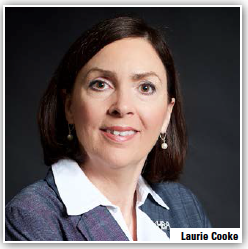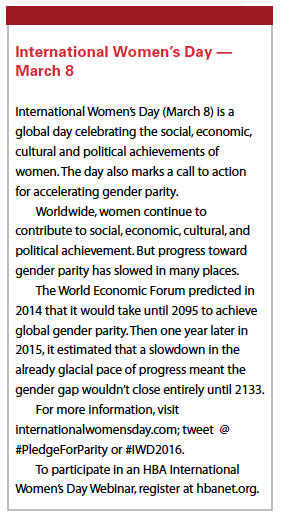Addressing the Gender Gap
 Laurie Cooke, CEO of the Healthcare Businesswomen’s Association, talks about the importance of gender diversity and the HBA’s role in moving the needle.
Laurie Cooke, CEO of the Healthcare Businesswomen’s Association, talks about the importance of gender diversity and the HBA’s role in moving the needle.
PV: The HBA recently updated its mission to include addressing the gender gap that exists within the executive leadership ranks of the healthcare sector. After 30-plus years, why did the association decide to put a stake in the ground in 2016?
Cooke: The HBA is dedicated to furthering the advancement and impact of women in healthcare worldwide. During a board of directors’ strategic planning session, we challenged ourselves to put forward more metrics and measures of the important work that we’re doing — building business networks, producing strong mentoring programs, advancing skills and industry knowledge, and celebrating women leaders as role models. One of the metrics we identified is to measure the representation of women in leadership positions in the C-suite and one level below. We believe if we can harness the power of connecting what we are doing as an association and what companies are doing to advance women, we can achieve greater and quicker results in moving the gender parity needle.
Intuitively, we know from individual success stories, that we are accomplishing our mission, by putting a measurement to these narratives we can also prove we are making a difference. This is a tangible way of putting a stake in the ground around the important issue of gender parity. Several studies estimate that it could take anywhere from 80 to 100 years before there is true gender parity in the workforce. At the HBA, we believe we can’t wait that long.
 There are a number of different ways to look at gender parity, all of which have merit and resonate on multiple levels. Our working definition of gender parity is: equal representation, based on the available market of ready talent, at the senior leadership level. At the HBA, we are already developing a strong talent pool of women and showcasing these role models as part of our mission.
There are a number of different ways to look at gender parity, all of which have merit and resonate on multiple levels. Our working definition of gender parity is: equal representation, based on the available market of ready talent, at the senior leadership level. At the HBA, we are already developing a strong talent pool of women and showcasing these role models as part of our mission.
The other question we asked ourselves is why are we doing this, to what end? There are multiple studies that have shown that companies with a higher proportion of women on their executive leadership teams and boards have a better financial performance. Furthermore, studies show that women create a more inclusive and collaborative work environment. And by doing this, it increases the engagement and contributions from the whole team. Generally speaking, women tend to make sure the brain power and perspectives of the whole team are leveraged, and because of this companies are realizing higher levels of innovation and improved decision-making.
PV: Looking forward to 2020, what do you consider to be the biggest challenge or challenges in achieving gender parity in the next five or so years?
Cooke: Achieving gender parity is a complex challenge that requires education around a number of different leadership, organizational, and cultural issues. A company has to believe that achieving gender parity is worth the investment. For gender diversity programs to be successful they need to be integrated into how businesses operate, how work gets done, etc. There has to be a business rationale that connects programs to results. For efficiency, changes can be made in a focused way to those business processes that will actually impact parity, versus a shot-gun approach hoping for the best.
The second area is addressing second-generation bias, which is often embedded into organizational practices and this can be very hard to detect. People use the phrase “it’s in the water" because it doesn’t tend to be a more visible bias that one can touch or see, but these are stereotypes that can prevent women leaders from thriving and reaching their full potential.
When women feel empowered, they more readily step up for leadership roles, and this is facilitated by sponsors who support them.
PV: Why is the HBA qualified to take up this mantle of responsibility?
Cooke: Gender parity links back to our mission. The HBA is a global nonprofit organization comprised of individuals and organizations from across the healthcare industry spectrum. For almost 40 years, the association has been dedicated to furthering the advancement and impact of women in the business of healthcare; currently we have a 46,000-plus strong community of women and men. We have more than 120 corporate partner companies and our reputation as a convener community of thought leaders and executives who address issues of importance has grown. We excel at identifying and recognizing excellent leadership, and we do that both for the individual and company. We have the ability to tap into an amazing source of women and men. As the CEO, I believe this is natural next step for the HBA to start to drive the call for the industry to significantly reduce the time recent studies have estimated that it will take to achieve gender parity.
We’ve got the numbers, we’ve got the longevity, and we’ve got the reputation of being able to make a difference. (PV)










